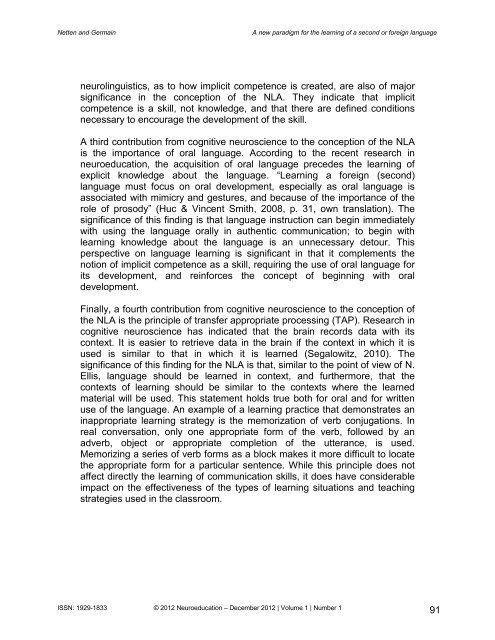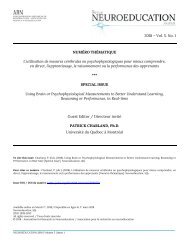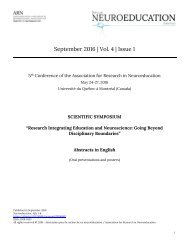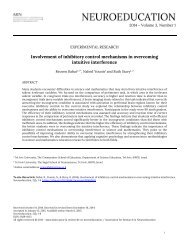Neuroeducation_2012_vol-1_no-1_full
Neuroeducation journal - Volume 1, Issue 1 (2012) - 144 pages
Neuroeducation journal - Volume 1, Issue 1 (2012) - 144 pages
You also want an ePaper? Increase the reach of your titles
YUMPU automatically turns print PDFs into web optimized ePapers that Google loves.
Netten and Germain<br />
A new paradigm for the learning of a second or foreign language<br />
neurolinguistics, as to how implicit competence is created, are also of major<br />
significance in the conception of the NLA. They indicate that implicit<br />
competence is a skill, <strong>no</strong>t k<strong>no</strong>wledge, and that there are defined conditions<br />
necessary to encourage the development of the skill.<br />
A third contribution from cognitive neuroscience to the conception of the NLA<br />
is the importance of oral language. According to the recent research in<br />
neuroeducation, the acquisition of oral language precedes the learning of<br />
explicit k<strong>no</strong>wledge about the language. “Learning a foreign (second)<br />
language must focus on oral development, especially as oral language is<br />
associated with mimicry and gestures, and because of the importance of the<br />
role of prosody” (Huc & Vincent Smith, 2008, p. 31, own translation). The<br />
significance of this finding is that language instruction can begin immediately<br />
with using the language orally in authentic communication; to begin with<br />
learning k<strong>no</strong>wledge about the language is an unnecessary detour. This<br />
perspective on language learning is significant in that it complements the<br />
<strong>no</strong>tion of implicit competence as a skill, requiring the use of oral language for<br />
its development, and reinforces the concept of beginning with oral<br />
development.<br />
Finally, a fourth contribution from cognitive neuroscience to the conception of<br />
the NLA is the principle of transfer appropriate processing (TAP). Research in<br />
cognitive neuroscience has indicated that the brain records data with its<br />
context. It is easier to retrieve data in the brain if the context in which it is<br />
used is similar to that in which it is learned (Segalowitz, 2010). The<br />
significance of this finding for the NLA is that, similar to the point of view of N.<br />
Ellis, language should be learned in context, and furthermore, that the<br />
contexts of learning should be similar to the contexts where the learned<br />
material will be used. This statement holds true both for oral and for written<br />
use of the language. An example of a learning practice that demonstrates an<br />
inappropriate learning strategy is the memorization of verb conjugations. In<br />
real conversation, only one appropriate form of the verb, followed by an<br />
adverb, object or appropriate completion of the utterance, is used.<br />
Memorizing a series of verb forms as a block makes it more difficult to locate<br />
the appropriate form for a particular sentence. While this principle does <strong>no</strong>t<br />
affect directly the learning of communication skills, it does have considerable<br />
impact on the effectiveness of the types of learning situations and teaching<br />
strategies used in the classroom.<br />
ISSN: 1929-1833 © <strong>2012</strong> <strong>Neuroeducation</strong> – December <strong>2012</strong> | Volume 1 | Number 1<br />
91








